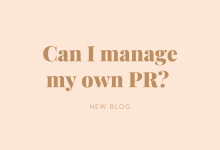Can I Manage My Own PR?
Dear Start-ups, entrepreneurs, thought leaders, creatives, CEOs, business leaders and change-makers…
One of the reasons I felt compelled to start my own PR agency back in 2011 was because I became acutely aware that not every business could sustain the cost of professional PR support. Yet every business absolutely needs a perennial PR function. And so I set out to create ways that all businesses could access world-class PR at any stage of their journey.
At a primitive level, PR is simply communicating with your people, internally and externally to your business. Every business needs to communicate. Your people are your existing audience, the audience reach you dream for, along with those already in your network. For example your supplier community, media, stakeholders and of course your own team.
Professional PR can be an unavailable option to business big and small, established and start-up. Just in the same way a 20 year old has limited available cash outside of basic needs (and Meredith tickets) as a 40 year old with childcare and mortgage demands. The bigger and more mature the business, the more costs – more money more demands. Therefore limited capacity for PR is not always a problem exclusive to start-ups with just a dime.
My vision for the future is that all businesses will be able to access world-class PR. Because other than the essentials to managing a successful business (on-point branding and design, incredible product or service, and an amazing and accessible customer experience); PR is the single most important thing for business growth and long-term prosperity.
So, yes. If you can’t hire a PR agency. You need to manage your own PR. And good news for you is that you can. Yes, you can manage your own PR. In some capacity you always should. And here are some ways to kick your PR function into gear until you’re ready to hand that gig over to a team who can do it for you.
01 Messaging, brand values and your why.
First up, you’ve gotta get clear on the key messaging for your business (product launch, or special project) before you can communicate anything. Otherwise you’ll sound like scrambled eggs, trying to appeal to one and all and in the process connecting with no one in a significant, compelling or engaging way. If you’re not sure on how to define your key messages go back to gaol (do not pass go) and get clear on your intentions for your business. Take some time to mull what your vision is, why your business exists, what your personal values are (they’re not different to brand values). Once you know your vision and ideal outcomes you can unlock the clarity you need for defining key messages.
02 Define your tone-of-voice
Tone-of-voice is the tone you set for communication with your ideal audience. It should be consistent and infinite. Sure 25 year olds might shop with your brand, as well as 55 year olds. But if you start adjusting the way you speak to serve the needs of everyone, you’ll actually confuse your audience and diffuse brand impact. Sportsgirl for example, never deviates from a 19 year old voice. But a 35 year old will buy a basic white tee and a 15 year old will buy a scrunchie. Sportsgirl doesn’t lose the sale of the audiences outside of their target group by being deliberate in who and how they communicate to. What they do though, is build an incredibly strong and identifiable brand.
Definitely get clear on your tone-of-voice, and personify your business comms with a list of traits and psychographics. It’ll help build a strong brand identity so you’ll attract your key target audience, communicate clearly and set yourself up for the best chance of word-of-mouth PR, media take-up and social media impact.
03 Reputation management
The other day I was chatting to an interior design friend who was frustrated at the lack of traditional, mainstream, lifestyle/design media take up on her projects. Her work is incredible. But it’s a competitive market. Cut-through isn’t easy. My answer is always; why wait for someone to tell your story. No longer are there media gatekeepers on publicity. And while media coverage in national long-lead magazines is excellent social proof, third-party endorsement and brand positioning; there are so many additional ways to share your story, value and unique point-of-difference. Consider all the platforms you have available to you and go for gold. Media will be more likely to take up your story if they themselves can get familiar with your brand outside of a single pitch and press release.
04 Build up your online real-estate
When it comes to new business acquisition through search, if Google says you’re no one then sadly, you kind of are. Therefore additionally to the above; don’t just leave it to traditional media to share your story, start sharing your (your businesses) story and managing your own reputation through your website’s blog, referral links, social media platforms (do not forget LinkedIn), and be sure to produce video content that brings value to your audience via Insta Stories and YouTube if long form content is not your thing. The more online assets you have PRing your business, the more reputation management real estate you have optimising search, generating brand awareness and ultimately increasing enquiry and sales.
05 Research and understand what constitutes a story
A big part of the PR function is research. It’s time consuming but helps with precision on pitching to media and securing coverage. In order to hatch your media strategy and perfect your pitch, first put your journalistic investigative hat on and understand what constitutes a story. Get clear on the media outlets interested in stories similar to those around your business. Know what your key media write about and how. By doing this you’ll unearth ideas on how to pitch your business to ensure it’s well-placed for editorial consideration.
06 Create a media and influencer list
Ok, so I’m going to let you in on a little secret…the best way to list-build is to search the coverage your peers and competitors are getting. This PR hack will help you generate a list of outlets and journalists as well as influencers who are interested in articles relevant to your business. Media come and go from publications daily; so the best way to secure up-to-the minute media lists is to reverse engineer peer coverage. Of course on top of that you’ll have additional outlets that come to mind; and you can also purchase media lists for your industry. Be mindful however that bought lists can often (mostly) be out-dated and cumbersome. They often need knocking into shape. A triple pronged approach is always best.
07 Find your key media and engage
Know who you’re pitching to before you pitch. The best way to do this is to follow them. Not in a creepy way, but in a way that builds authentic connection and allows you to be familiar with what they write about and their readership. PR is a ‘relationship first’ business. Who are going to listen to when a suggestion or recommendation comes your way; a friend that knows you, what you’re interested in and how you roll, or a complete and utter stranger just trying to sell something.
08 Pitch, re-angle, and pitch again (personalise)
When you’re confident and ready to pitch, make sure your outreach efforts are value based and personalised. What’s in it for the journalist, why should they be interested, why would their readers be interested? If you miss the mark the first time, revisit all the previous tips; re-angle, re-align and re-pitch with value and connection in mind.
09 Follow-up
As long as what you’re pitching is relevant and brings value to the journalist, and their audience; don’t underestimate the power of friendly follow-up. Media and influencers get a deluge of story opportunities every day. To keep yours top-of-mind, it’s important to follow-up. Just don’t be a pest or you’ll get black-listed. In my opinion follow-up is an art form and is the difference between good and bad PR and whether your story gets a run or not.
So, yes you can take matters into your own hands. And everyone can become better at PR. Do keep in mind however, that perception is hard to change. So it’s important that the first interaction media (who are actual humans) have with your brand is thoughtful, relevant and meaningful.
Words by Jade Roberts
raraPR Founder and Director
raraPR is above all the sum of people who together help build brands and share stories. We are present in our determination to make a positive difference to the world by representing individuals and businesses that are doing good. We are an extension of the personal stories within us, those that we exist for and those within you that need to be heard.



